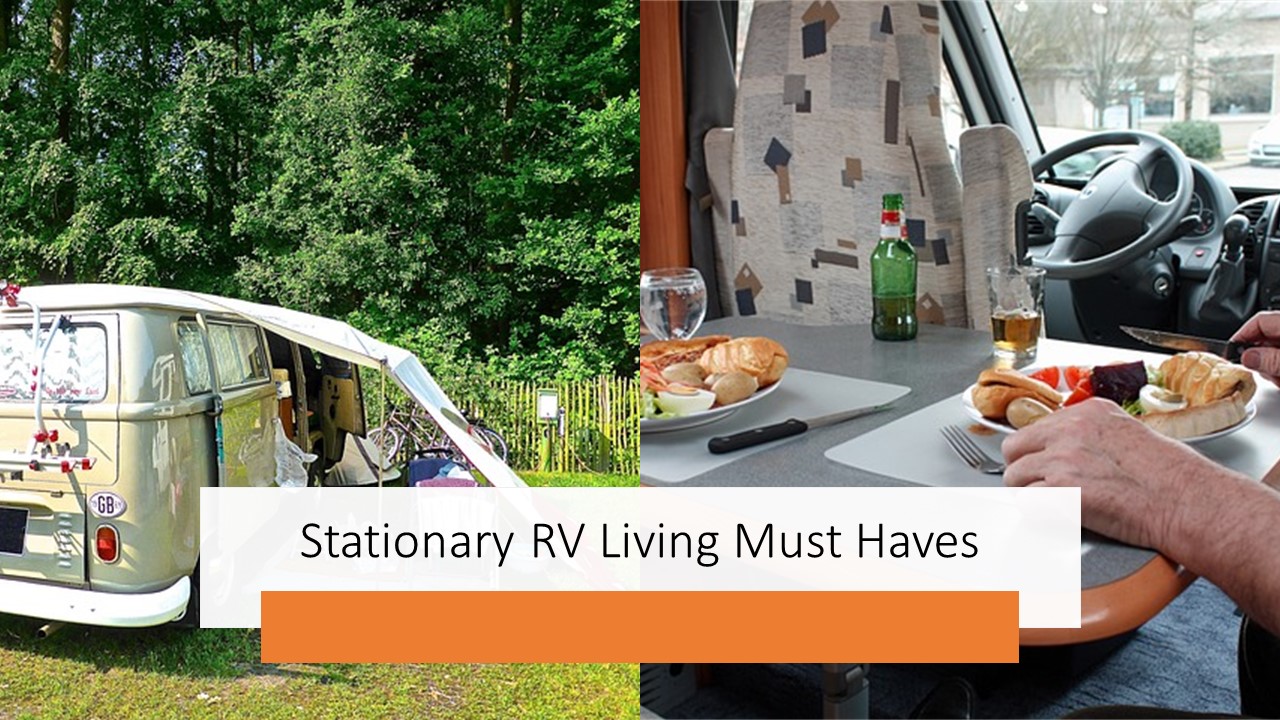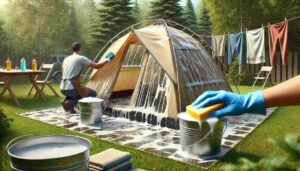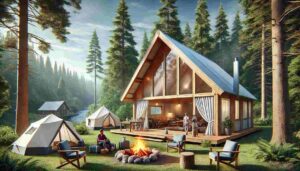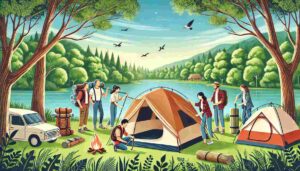The concept of stationary RV living has gained significant popularity in recent years, offering a unique and fulfilling lifestyle for many individuals and families. Stationary RV living involves setting up your recreational vehicle in a permanent location, such as an RV park, a piece of land, or even a backyard, and transforming it into a comfortable and functional living space. This alternative way of living combines the freedom and flexibility of RV living with the stability and convenience of a traditional home. In this comprehensive article, I will delve into the world of stationary RV living and explore the must-haves essentials that can help you create a cozy and efficient living environment. Whether you’re considering transitioning to stationary RV living full-time or seeking a vacation home on wheels, this article will provide you with valuable insights and expert advice to make the most of your stationary RV lifestyle.
I hope that by showcasing my experience and offering a trustworthy resource, I empower you to embrace the stationary RV living experience with confidence. From setting up the perfect location and utilities to choosing the essential furniture, appliances, and supplies, I will cover every aspect of stationary RV living must-haves in detail. Let’s embark on this exciting journey and discover how to create a comfortable, functional, and personalized stationary RV space that truly feels like home.
Setting Up Your Stationary RV
Before you can fully enjoy the benefits of stationary RV living, it’s crucial to set up your RV in the most suitable location and ensure that it is equipped with the necessary utilities. Here are the essential steps to follow when setting up your stationary RV:
1. Choosing the ideal location:
- Research RV parks or private lands: Look for reputable RV parks that offer long-term or seasonal stays. Alternatively, consider private lands or properties where you can legally park your RV.
- Amenities and facilities: Consider the amenities and facilities available at the location, such as laundry facilities, recreational areas, swimming pools, or proximity to essential services like grocery stores and medical facilities.
- Climate and environment: Assess the climate and environment of the location to ensure it aligns with your preferences and needs. Consider factors such as temperature, humidity, proximity to nature or urban areas, and potential exposure to extreme weather conditions.
2. Preparing the RV site:
- Leveling the ground: Use leveling blocks or jacks to ensure that your RV is parked on a level surface. This step is essential for stability and preventing any issues with the RV’s systems.
- Clearing the site: Remove any debris, rocks, or obstacles that may hinder the placement of your RV or cause damage.
- Parking considerations: Position your RV in a way that maximizes space, privacy, and accessibility. Consider factors such as sunlight exposure, views, and proximity to common areas or amenities within the park or property.
- Outdoor living space: Create an outdoor living area adjacent to your RV by defining the space with outdoor rugs, patio furniture, and planters. This area will serve as an extension of your living space and provide opportunities for relaxation and entertainment.
3. Hooking up utilities:
- Water hookup: Connect your RV to a potable water source using a water hose and ensure a secure and leak-free connection. Consider using a water pressure regulator to protect your RV’s plumbing system from high water pressure.
- Electricity hookup: Connect your RV to a reliable power source using a heavy-duty extension cord or a dedicated RV electrical hookup. Be aware of the electrical capacity available and ensure that your RV’s electrical requirements are compatible.
- Sewage hookup: Connect your RV’s sewage system to a designated sewage hookup or septic system. Use appropriate hoses and connectors to ensure a secure and sanitary connection. Consider using sewage tank additives to promote proper tank maintenance and odor control.
4. Safety considerations:
- Fire safety: Install smoke detectors and carbon monoxide detectors inside your RV to ensure early detection of potential hazards. Additionally, have fire extinguishers readily available and familiarize yourself with their usage.
- Emergency exits: Ensure that all emergency exits, including doors and windows, are fully functional and easily accessible in case of emergencies.
- Personal safety: Implement security measures, such as installing sturdy locks on doors and windows, to safeguard your RV and belongings. Consider using window tint or curtains for added privacy and security.
Essential Furniture and Appliances
When it comes to creating a comfortable and functional living space in your stationary RV, selecting the right furniture and appliances is key. Here are the essential items you’ll need:
1. Sleeping arrangements:
- Beds: Choose a bed that suits your preferences and available space, such as a fixed bed, convertible sofa bed, or foldable Murphy bed. Consider the size (twin, full, queen, or king), comfort level, and storage options (under-bed storage or built-in drawers).
- Mattresses: Invest in a high-quality mattress that provides optimal comfort and support for a good night’s sleep. Consider options like memory foam, hybrid, or air mattresses, depending on your preferences.
- Bedding: Ensure you have appropriate bedding essentials, including sheets, pillows, pillowcases, blankets, and comforters, to enhance your sleeping experience.
2. Seating options:
- Sofas, recliners, or chairs: Choose comfortable seating options that fit your available space and seating needs. Opt for versatile furniture pieces that may have built-in storage compartments.
- Dining area: Consider a dining table and chairs or a dinette set that accommodates your dining needs. Look for options that can be easily folded or expanded to save space.
3. Storage solutions:
- Shelves and cabinets: Utilize vertical space by installing shelves or cabinets to store items like books, clothing, kitchenware, and personal belongings.
- Wardrobes and closets: Invest in wardrobes or closets to organize and store your clothes efficiently. Look for options with adjustable shelves, hanging rods, and drawers.
- Under-bed storage: Maximize storage space by using storage bins or drawers that fit under your bed.
- Multi-purpose furniture: Consider furniture pieces that serve dual functions, such as ottomans with hidden storage, coffee tables with built-in shelves or drawers, or benches with storage compartments.
4. Kitchen appliances:
- Refrigerator: Choose an energy-efficient RV refrigerator that fits your storage needs. Consider options like compact models or those with separate freezer compartments.
- Stove and oven: Select a propane or electric stove with a matching oven for cooking meals. Ensure that it is properly installed and meets safety requirements.
- Microwave: Invest in a compact microwave for quick heating and cooking convenience.
- Dishwasher: If space and budget allow, consider a compact RV dishwasher to simplify your dishwashing routine.
5. Bathroom fixtures:
- Toilet: Choose an RV-specific toilet that conserves water and fits the available space in your bathroom area.
- Shower: Opt for a compact shower unit or a shower pan with a curtain or door enclosure, depending on your RV’s layout.
- Vanity: Install a space-saving vanity with a sink and storage compartments for your toiletries.
Selecting the right furniture and appliances for your stationary RV is crucial to ensure comfort, functionality, and efficient use of space. Take measurements, consider multi-purpose furniture, and invest in high-quality items that are designed specifically for RVs.
Climate Control and Comfort
Maintaining a comfortable living environment inside your stationary RV is essential for year-round enjoyment. Here are some key considerations for climate control and comfort:
1. Heating options:
- Electric heaters: Choose portable electric heaters or wall-mounted units that provide efficient and adjustable heat. Consider models with built-in thermostats and safety features like tip-over protection.
- Propane heaters: Opt for propane-powered heaters designed for RV use. Ensure proper ventilation and follow safety guidelines when using propane heaters.
- Wood-burning stoves: If allowed and suitable for your setup, consider installing a wood-burning stove for cozy warmth. Ensure proper installation, venting, and compliance with local regulations.
2. Cooling options:
- Air conditioners: Install RV-specific air conditioning units to keep your living space cool during hot summer months. Choose between roof-mounted or portable units based on your RV’s layout and power capacity.
- Fans: Use portable fans or ceiling fans to enhance air circulation and provide additional cooling. Consider options with adjustable speeds and oscillation features for optimal comfort.
- Ventilation systems: Install roof vents or window vents to promote airflow and prevent condensation. Consider options with built-in fans for efficient ventilation.
3. Insulation and weatherproofing:
- Insulation: Enhance insulation in your stationary RV to regulate temperature and reduce energy consumption. Consider adding insulation to walls, floors, and ceilings, as well as using insulated window coverings.
- Weatherstripping: Seal gaps and cracks around doors and windows with weatherstripping to prevent drafts and maintain a comfortable indoor temperature.
- Skirting: Use skirting around the bottom of your RV to create a barrier against cold drafts and improve insulation during colder seasons.
4. Window coverings:
- Blinds: Install blinds that allow you to adjust light and privacy levels while providing insulation. Consider options like cellular blinds that trap air for better insulation.
- Curtains or shades: Choose curtains or shades made from insulating materials to block out light, regulate temperature, and add a touch of style to your interior.
5. Adequate lighting:
- LED bulbs: Replace traditional light bulbs with energy-efficient LED bulbs to reduce power consumption and prolong battery life. LEDs also produce less heat, making them safer for RV use.
- Task lighting: Install task lighting in areas where focused illumination is needed, such as above workspaces, reading nooks, or dining areas.
- Natural light: Maximize natural light by keeping windows clean and unobstructed. Consider adding skylights or sunroofs if feasible to allow more natural light into your RV.
Creating a comfortable climate and optimizing indoor comfort in your stationary RV will greatly enhance your living experience.
Connectivity and Entertainment
In today’s connected world, having reliable connectivity and entertainment options is essential for a fulfilling stationary RV living experience. Here are some key considerations to ensure you stay connected and entertained:
1. Internet and mobile connectivity options:
- Mobile hotspots: Consider using a mobile hotspot device or tethering your smartphone to provide internet connectivity in your RV. Research different providers and plans to find one that offers reliable coverage in your area.
- RV park Wi-Fi: Many RV parks offer Wi-Fi services, but the quality and reliability can vary. Check with the park management to understand the Wi-Fi availability, speed, and any associated fees.
- Signal boosters: If you often struggle with weak mobile signals, consider investing in a signal booster to improve connectivity inside your RV. These devices amplify signals from nearby cell towers, providing a stronger and more reliable connection.
2. TV and entertainment systems:
- TV options: Choose a TV that fits the available space in your RV. Opt for a flat-screen TV with energy-efficient LED technology. Consider whether you prefer a smart TV with built-in streaming capabilities or a regular TV with external streaming devices.
- Satellite TV: If you desire a wide range of TV channels, consider subscribing to a satellite TV service specifically designed for RVs. These services offer portable satellite dishes and receivers for easy setup and access to a variety of channels.
- Streaming services: Take advantage of popular streaming services like Netflix, Amazon Prime Video, or Hulu by connecting your RV to the internet. Ensure you have sufficient data or Wi-Fi access to stream your favorite movies, shows, and documentaries.
3. Audio systems and speakers:
- Stereo systems: Install a compact stereo system or a Bluetooth-enabled soundbar to enhance your audio experience in the RV. Consider models that offer multiple connectivity options and have space-saving designs.
- Outdoor speakers: If you enjoy outdoor living, consider installing weather-resistant outdoor speakers to enjoy music or podcasts while relaxing outside your RV. Ensure they are properly mounted and connected to your audio system.
4. Gaming and recreational equipment:
- Gaming consoles: If you or your family members enjoy gaming, consider bringing a gaming console that fits your preferences, such as Xbox, PlayStation, or Nintendo Switch. Connect the console to your TV and enjoy gaming entertainment on the go.
- Outdoor equipment: Embrace outdoor activities by bringing along recreational equipment like bicycles, kayaks, or hiking gear. Take advantage of the surrounding nature and engage in activities that bring you joy and relaxation.
Remember to plan your connectivity and entertainment options based on your personal preferences and the availability of services in your location. Whether you prefer streaming your favorite shows, staying connected to work or social media, or indulging in outdoor activities, ensuring reliable connectivity and having a range of entertainment options will enrich your stationary RV living experience.
Essential Kitchen and Dining Supplies
A well-equipped kitchen is vital for preparing meals and enjoying dining experiences in your stationary RV. Here are the essential kitchen and dining supplies you’ll need:
1. Cookware and utensils:
- Pots and pans: Invest in a set of durable and versatile pots and pans in various sizes. Consider non-stick options for easier cooking and cleaning.
- Skillet: Have a skillet or frying pan for cooking items like eggs, pancakes, and stir-fries.
- Baking sheets and dishes: Include baking sheets and dishes for oven use, such as baking cookies, roasting vegetables, or baking casseroles.
- Cooking utensils: Ensure you have a range of cooking utensils, including spatulas, tongs, stirring spoons, measuring cups, and measuring spoons.
- Knives: Invest in a set of sharp and high-quality knives, including a chef’s knife, paring knife, and bread knife, for various kitchen tasks.
- Cutting boards: Have a selection of cutting boards for food preparation, including a separate one for meats and vegetables to prevent cross-contamination.
2. Food storage containers and pantry organization:
- Storage containers: Use a variety of food storage containers, including airtight containers, plastic bags, and wraps, to store leftovers and keep ingredients fresh.
- Pantry organization: Utilize storage solutions like stackable containers, bins, and spice racks to keep your pantry well-organized and easily accessible.
3. Small appliances:
- Coffee maker: If you’re a coffee enthusiast, consider a compact coffee maker that fits your preferences, whether it’s a drip coffee maker, French press, or single-serve machine.
- Toaster or toaster oven: Enjoy toasted bread, bagels, or pastries with a toaster or toaster oven.
- Blender or food processor: If you enjoy making smoothies, sauces, or soups, consider a blender or food processor for easy preparation.
4. Dinnerware and cutlery:
- Plates, bowls, and glasses: Invest in a set of lightweight and durable plates, bowls, and glasses designed for RV use. Consider stackable or collapsible options to save space.
- Cutlery: Have a set of stainless steel cutlery, including forks, knives, spoons, and teaspoons, for everyday dining needs.
- Mugs and cups: Include a selection of mugs and cups for enjoying hot beverages or drinks.
5. Cleaning supplies:
- Dish soap and sponges: Have dish soap and sponges for cleaning dishes and cookware.
- Dish rack: Opt for a compact dish rack that fits your available counter space to dry dishes efficiently.
- Cleaning sprays and wipes: Keep cleaning sprays, wipes, or multi-purpose cleaners on hand for quick and easy cleanup.
Remember to consider your available storage space when selecting kitchen and dining supplies. Opt for compact and multi-purpose items whenever possible to maximize efficiency and minimize clutter.
Efficient Space Utilization
Making the most of the limited space in your stationary RV is crucial for a comfortable and organized living environment. Here are some tips for efficient space utilization:
1. Utilizing vertical space:
- Shelves and hooks: Install shelves or hooks on walls to store items such as books, kitchen utensils, towels, or clothing. Utilize vertical space to keep items off the floor and countertops.
- Overhead storage: Make use of overhead cabinets and storage compartments for items you don’t frequently need access to. Use labeled bins or baskets to keep items organized and easily identifiable.
- Hanging storage solutions: Opt for hanging storage solutions, such as shoe organizers or hanging shelves, inside closets or on the back of doors, to maximize storage space for smaller items.
2. Foldable and collapsible furniture:
- Folding tables: Consider using folding tables that can be expanded when needed and folded away when not in use. These tables provide additional workspace or dining area when required.
- Foldable chairs: Invest in foldable chairs that can be easily stored when not in use, saving space in your living area or outdoor space.
- Collapsible storage containers: Use collapsible storage containers or bins to store items when they are not in use. These containers can be easily folded and stored away when empty.
3. Multipurpose items and storage solutions:
- Furniture with built-in storage: Choose furniture pieces that serve dual purposes, such as ottomans or sofas with built-in storage compartments. These items provide extra storage while serving their primary function.
- Convertible furniture: Consider convertible furniture options, such as sofa beds or dining tables that can be expanded or collapsed, to maximize functionality and save space.
- Stackable or nesting items: Use stackable or nesting items, such as nesting bowls or stacking bins, to save space when storing items like kitchenware or pantry items.
4. Decluttering strategies and organization tips:
- Regular decluttering: Adopt a habit of regular decluttering to eliminate items you no longer need or use. Donate or sell items that are still in good condition but not essential for your stationary RV living.
- Optimize storage solutions: Use organizers, dividers, and storage bins to keep items neatly arranged and easily accessible. Label containers to quickly find what you need.
- Minimalist mindset: Embrace a minimalist mindset by keeping only the essentials and items that bring you joy. Avoid excessive purchases and focus on functional and meaningful items.
With smart storage solutions, multipurpose furniture, and a commitment to decluttering, you’ll maximize every square inch and enjoy a more comfortable and functional living space.
Safety and Security
Ensuring the safety and security of your stationary RV is of utmost importance for a worry-free living experience. Here are some essential considerations:
1. RV security systems:
- RV alarm system: Install a security alarm system specifically designed for RVs to deter potential intruders. These systems often include motion sensors, door/window sensors, and alarms.
- Surveillance cameras: Consider installing surveillance cameras around your RV to monitor the surrounding area. Choose cameras with night vision capabilities and remote access features for added convenience.
2. Safety equipment:
- Fire extinguishers: Keep multiple fire extinguishers in easily accessible locations within your RV. Ensure they are regularly inspected, properly maintained, and within their expiration dates.
- Smoke detectors and carbon monoxide detectors: Install smoke detectors and carbon monoxide detectors inside your RV to provide early warning of potential hazards. Regularly test and replace batteries as needed.
- Emergency exit plan: Develop an emergency exit plan with all occupants of the RV and ensure everyone knows how to exit the vehicle safely in case of an emergency.
3. Locks and reinforcements:
- Door and window locks: Install sturdy locks on all entry doors and windows to prevent unauthorized access. Consider upgrading to high-security locks or deadbolts for added protection.
- Reinforced entry points: Strengthen entry points, such as doors and storage compartments, with additional security measures like reinforced strike plates or latch guards.
- Hitch lock: If your RV is parked on a trailer or has a hitch, use a hitch lock to secure it and prevent theft.
4. RV insurance and liability coverage:
- RV insurance: Ensure your stationary RV is adequately insured with an RV-specific insurance policy. This coverage should include liability protection, property damage coverage, and comprehensive coverage against potential risks.
- Liability coverage: Consider obtaining liability coverage to protect yourself from accidents or injuries that may occur on or around your RV. Consult with an insurance professional to determine the appropriate coverage for your needs.
Maintaining a secure and safe environment is essential for your peace of mind during your stationary RV living experience.
Outdoor Living Essentials
Creating an inviting and functional outdoor living space is an integral part of stationary RV living. Here are some essential items to consider for your outdoor area:
1. Outdoor furniture:
- Chairs and loungers: Invest in comfortable outdoor chairs or loungers for relaxing and enjoying the outdoors.
- Tables: Consider a table or a folding table for outdoor dining, socializing, or working.
- Umbrella or shade canopy: Provide shade and protection from the sun with an umbrella or a shade canopy. This will allow you to enjoy your outdoor space even on hot days.
2. Awning or shade solutions:
- Retractable awning: Install a retractable awning on the exterior of your RV to create a shaded area outside. This can be an extension of your living space and protect you from sun and light rain.
- Canopy or gazebo: Set up a canopy or gazebo adjacent to your RV for a covered outdoor area. This provides additional protection from the elements and creates a comfortable outdoor gathering space.
3. Grilling and outdoor cooking equipment:
- BBQ grill: Invest in a portable BBQ grill or a built-in outdoor grill to enjoy cooking and dining al fresco. Consider the type (charcoal, gas, or electric) that suits your preferences and space limitations.
- Outdoor cooking accessories: Gather essential grilling tools, such as spatulas, tongs, grill brushes, and skewers, to enhance your outdoor cooking experience.
4. Outdoor lighting options:
- String lights: Add a warm and inviting ambiance with string lights hung around your outdoor living area. Choose weather-resistant options designed for outdoor use.
- Solar-powered lights: Place solar-powered lights along walkways or in your outdoor space to provide illumination at night. These lights are energy-efficient and do not require wiring.
Remember to consider the available space and your personal preferences when selecting outdoor living essentials. Create an outdoor area that suits your lifestyle, whether it’s for relaxation, entertaining guests, or enjoying meals under the open sky.
Maintenance and Upkeep
Regular maintenance and upkeep are essential for keeping your stationary RV in good condition and ensuring a comfortable and safe living environment. Here are some important aspects to consider:
1. RV maintenance checklist:
- Regular inspections: Conduct routine inspections of your RV’s exterior, interior, and mechanical systems to identify any signs of wear, damage, or leaks.
- Roof maintenance: Check the roof for any cracks, tears, or damage. Clean the roof regularly and ensure proper sealing to prevent water leaks.
- Seals and caulking: Inspect and maintain seals and caulking around windows, doors, vents, and other openings to prevent water intrusion and maintain energy efficiency.
- Tire maintenance: Regularly inspect tire pressure, tread wear, and overall condition. Rotate tires as recommended by the manufacturer and replace them when necessary.
- Propane system checks: Test the propane system for leaks, ensure proper functioning of appliances, and have the system professionally inspected as needed.
- Battery maintenance: Keep your RV’s batteries charged and maintained according to the manufacturer’s instructions. Clean battery terminals and replace batteries when necessary.
- Plumbing system maintenance: Regularly inspect plumbing connections, fixtures, and pipes for leaks or damage. Flush tanks and clean water lines periodically to maintain water quality.
- Electrical system checks: Test electrical outlets, lights, and appliances regularly to ensure proper functioning. Address any electrical issues promptly and consult a professional if needed.
2. Cleaning and sanitation tips:
- Interior cleaning: Regularly clean the interior of your RV, including floors, walls, countertops, and furniture. Use RV-specific cleaning products that are compatible with the materials used in your RV.
- Exterior cleaning: Wash the exterior of your RV regularly to remove dirt, grime, and road debris. Use RV-friendly cleaning products and a soft brush or sponge to avoid damaging the finish.
- Waste tank maintenance: Follow proper waste tank maintenance procedures, including emptying and cleaning the tanks as needed. Use RV-friendly tank treatments to control odors and promote waste breakdown.
- Ventilation and air circulation: Maintain good ventilation by opening windows or using vents to reduce moisture and prevent mold and mildew growth. Use dehumidifiers if necessary.
3. Regular inspections and repairs:
- Proactive repairs: Address any issues or repairs promptly to prevent further damage and ensure a safe and comfortable living environment.
- Professional inspections: Schedule regular professional inspections for your RV’s systems, including propane, electrical, and plumbing, to identify any hidden issues and ensure proper functioning.
- Weather-related considerations: Take necessary precautions during extreme weather conditions such as winterizing your RV to protect it from freezing temperatures or securing it against strong winds.
4. Winterizing and weather-related considerations:
- Winterization: If you live in a cold climate or plan to leave your stationary RV during the winter months, follow proper winterization procedures. This includes draining water lines, adding antifreeze, and protecting vulnerable areas from freezing temperatures.
- Weatherproofing: Ensure your RV is adequately weatherproofed to prevent drafts, leaks, and excessive heat or cold. Use weatherstripping, insulation, and skirting to enhance insulation and protect against the elements.
Regular maintenance, cleaning, and proactive repairs are key to preserving the longevity and functionality of your stationary RV.
Personalization and Comfort
Making your stationary RV feel like home involves personalization and creating a comfortable and inviting space that reflects your unique style and preferences. Here are 6 tips for personalization and enhancing comfort:
1. Decorative items and personal touches:
- Wall decor: Hang artwork, photographs, or decorative mirrors on the walls to add personality and make your RV feel more like home.
- Throw pillows and blankets: Incorporate throw pillows and blankets in various colors, patterns, and textures to add comfort and style to your seating areas.
- Window treatments: Install curtains, blinds, or shades in fabrics and patterns that complement your interior decor while providing privacy and light control.
2. Indoor plants and greenery:
- Choose low-maintenance houseplants that thrive in the limited space and conditions of an RV. Succulents, spider plants, and pothos are excellent choices.
- Use wall-mounted or hanging planters to maximize space and bring nature indoors.
- Indoor herb garden: Cultivate a small herb garden in your RV to have fresh herbs readily available for cooking.
3. Comfortable bedding and linens:
- Invest in high-quality bedding, including soft sheets, cozy blankets, and supportive pillows, to create a comfortable sleeping environment.
- Layer bedding with different textures and materials to add depth and warmth.
- Consider mattress toppers or pads for added comfort and support.
4. Hobbies and leisure activities:
- Create a designated space for your hobbies or leisure activities, such as a small desk for writing or crafting, a reading nook with a comfortable chair, or a dedicated space for yoga or exercise.
- Bring along your favorite books, board games, or other leisure activities that bring you joy and help you relax.
5. Lighting ambiance:
- Utilize various lighting options to create different moods and ambiance. Use dimmable or adjustable lighting fixtures to control brightness levels.
- Decorative string lights or battery-operated candles can add a cozy and relaxing atmosphere in the evenings.
6. Custom storage solutions:
- Maximize storage space by using custom storage solutions, such as hanging organizers, drawer dividers, or labeled bins, to keep your belongings organized and easily accessible.
- Utilize unused nooks and crannies by installing shelves, hooks, or storage compartments to create additional storage options.
Personalizing your stationary RV with decorative items, indoor plants, comfortable bedding, and incorporating hobbies and leisure activities will make it feel like a true home. Remember to prioritize comfort, functionality, and reflect your personal style throughout the space.
Conclusion
In conclusion, stationary RV living offers a unique and fulfilling lifestyle, combining the freedom and flexibility of RV living with the stability and convenience of a permanent home. By following this comprehensive guide to essential stationary RV living must-haves, you can create a comfortable, functional, and personalized living space that truly feels like home.
From setting up your stationary RV in an ideal location and hooking up utilities to selecting essential furniture, appliances, and supplies, each aspect has been covered in detail to showcase our expertise and provide you with a trustworthy resource.
I’ve also emphasized the importance of climate control and comfort, connectivity, and entertainment, safety and security, outdoor living essentials, maintenance and upkeep, as well as personalization and comfort. By addressing these aspects, you can create a well-rounded and enjoyable stationary RV living experience.
Remember, stationary RV living is a journey, and it’s important to continuously adapt and personalize your living space to suit your evolving needs and preferences. Embrace the freedom, simplicity, and adventures that come with this lifestyle, and make your stationary RV a place where you can relax, thrive, and create lasting memories.
I hope this article has provided you with valuable insights and guidance, instilling confidence and expertise as you embark on your stationary RV living journey. Enjoy the journey and make the most of this unique and fulfilling lifestyle.
You might also like: The Ultimate Guide To Full-Time RV Living Monthly Costs









